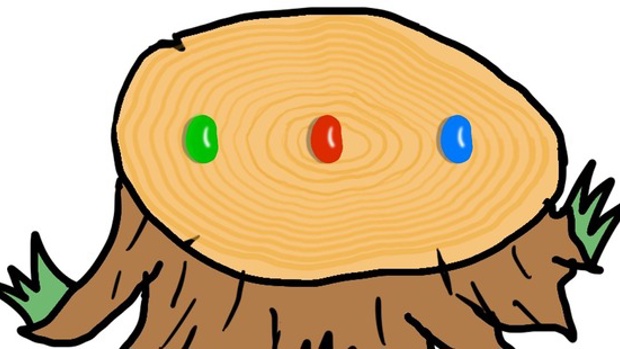This Jelly Bean Riddle Is The Latest Puzzle To Baffle The Internet
- Publish Date
- Friday, 22 April 2016, 3:01PM

You've found the hidden panda and sussed out the image contained in a seemingly solid red dot, but now there's a new head-scratching riddle sweeping the internet.
Tim Urban and Andrew Finn of the website butwaitwhy.com have created a fiendishly difficult puzzle based around three jelly beans...
You’re wandering through a faraway land one day when you pass a plum tree. Excited, you pick a plum from the tree, but just as you’re about to take your first bite, you’re confronted by a nearby man.
“You stole one of my plums,” he says.
You try to give the plum back and explain that you didn’t mean to steal from him, you just really like plums so you picked one.
“Those aren’t mutually exclusive,” he says. “It sounds like you both really like plums and meant to steal one from me.”
“I guess, yeah, but like…” you say.
“The penalty for stealing plums in our faraway land is death,” he says.
He takes you with him over to a tree stump and asks you to sit down next to the stump. He reaches in his pocket and takes out three jelly beans—a green one, a red one, and a blue one. He sits down on the other side of the stump and puts the three jelly beans on the stump in a row.
He says, “Here’s some good news. The way we do the death penalty here is that you have a chance to get out of it. Here’s the deal: Two of the jelly beans on the stump are poisonous—you’ll die within 30 seconds of eating either one of them. But one of the jelly beans isn’t poisonous and won’t harm you at all. All three of the jelly beans are delicious. The situation works like this: You pick one of the jelly beans and eat it, and if you happen to pick the non-poisonous one, you’re free to go. Cool?”
“Cool,” you say. He tells you it’s time to choose a jelly bean.
You choose the green one.
Before you put it in your mouth, the man stops you and says, “Wait a minute—there’s one other little tradition we have that we do with each prisoner. Hold on to your jelly bean. I’m going to remove one of the other two jelly beans and put it back in my pocket, and I’m going to remove a poisonous one. I know which colors are poisonous and which aren’t, and one thing I can tell you is that blue jelly beans are poisonous.”
He takes the blue jelly bean and puts it back in his pocket. That leaves the red jelly bean still on the stump and the green jelly bean still in your hand.
“Okay, time to eat your jelly bean,” he says. “Oh and we also always allow prisoners to change their mind up until the last second, so if you want to switch to the red one, you can. I don’t care. But you need to eat one of them in the next 10 seconds.”
So the question is—which jelly bean do you eat? Does it even matter?
Stop and think about what you’d do in this situation before moving on...
Here’s the weird thing about that question—yes, it matters. It matters a lot. Knowing only what you know in that situation, there is one clear choice: the red jelly bean.
My guess is that when you thought about it, you decided to stick with your original decision and eat the green one. Because with two jelly beans left, you had a 50/50 shot, and it feels better to stick with your original choice than to switch. Right?
Wrong. Very wrong.
The green jelly bean is double as likely to kill you as the red jelly bean. Here’s why:
When you initially picked the green jelly bean, there was a 1/3 chance that it was the safe one to eat, and a 2/3 chance that it was poisonous and the safe one was still on the stump. When the man removed a poisonous blue jelly bean from the stump, it told you no new info about the green jelly bean in your hand—that still had a 1/3 chance of being safe. But removing the blue jelly bean told you a lot about the red jelly bean—it told you that if the safe jelly bean had been on the stump, the red one is safe.
Put another way, if you picked a poisonous jelly bean—which you would do two-thirds of the time—then choosing to switch after he removes one will save you every time. If you picked the safe one to start off with—which happens one-third of the time—then switching will kill you. So switching is a good choice two-thirds of the time.
You could run a pretty quick simulation: If you ran this process 300 times and picked the green jelly bean each time, about 100 of the times, it would be safe to eat and switching to the red bean would kill you. The other 200 or so times, the green jelly bean would be poisonous and switching to the red bean would save you.
One other way to look at it is this—say instead of three jelly beans, the guy puts down 1,000 jelly beans and tells you again that only one is safe. So this time, instead of two poisonous jelly beans to contend with, there are 999. He labels them each with a number, 1-1,000, and asks you to choose. You choose jelly bean 267 and hold it in your hand, leaving 999 jelly beans on the stump. Then, while you hold onto jelly bean 267, the man removes 998 jelly beans from the stump and tells you that all 998 of them are poisonous. All that’s left on the stump is jelly bean 749. He tells you you can stick with jelly bean 267 or switch to jelly bean 749—what would you do?
You’d switch. Jelly bean 267 has a 1/1,000 chance of being safe. There’s nothing special about it. You picked it and it sat on the sidelines as 998 poisonous jelly beans were removed from the 999 on the stump. Jelly bean 749 is special—it’s the survivor. There’s a tiny, 1/1,000 chance that you happened to pick the non-poisonous jelly bean, and if that’s the case, then the man just took 998 jelly beans at random from 999 that were all poisonous. But far more likely is that the jelly bean you picked is one of the poisonous ones, meaning the stump only has 998 poisonous jelly beans on it. So when the man says he’s going to take 998 poisonous ones off the stump, he has no choice—he has to leave the safe one there, so jelly bean 749 is left there very intentionally. Jelly bean 749 is the one you want to eat—it’s been through the tough test and survived, while the one in your hand survived nothing and is super dangerous to eat.
Back to our three jelly bean situation. Same deal. The green jelly bean in your hand and its 1/3 odds of being safe were kept in isolation during the jelly bean removal process, so the 1/3 odds are still valid. But the red jelly bean survived the removal process and all the safe choices that might have been on the stump are now consolidated into the red jelly bean. That’s why you switch.
Take your Radio, Podcasts and Music with you


